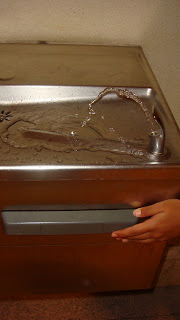

 Last weekend, when I was getting a drink of water during a break in a meeting, I noticed that the more I pushed on the water fountain button/lever/whatever it's called that the water would shoot up higher. I'm sure that all of us have done this at one point in time, shooting water up our friends' noses when they asked us to hold the lever down for them. Back then, this was just a silly prank, but now that I'm in physics I can see that this is actually the work of velocity and gravity! The higher the velocity that the water is shot out of the fountain (the more push that is applied to the lever), the higher the water will shoot out (the higher the peak of its motion), and vice versa. The arc that's formed from the flow of water is due to the pull of gravity, the negative acceleration of all objects on earth (-9.8 m/s^2). At the peak of the three pictured arcs, the velocity of the flow of the water is 0 m/s because it's changing from positive to negative, however, it's still accelerating since its velocity is changing.
Last weekend, when I was getting a drink of water during a break in a meeting, I noticed that the more I pushed on the water fountain button/lever/whatever it's called that the water would shoot up higher. I'm sure that all of us have done this at one point in time, shooting water up our friends' noses when they asked us to hold the lever down for them. Back then, this was just a silly prank, but now that I'm in physics I can see that this is actually the work of velocity and gravity! The higher the velocity that the water is shot out of the fountain (the more push that is applied to the lever), the higher the water will shoot out (the higher the peak of its motion), and vice versa. The arc that's formed from the flow of water is due to the pull of gravity, the negative acceleration of all objects on earth (-9.8 m/s^2). At the peak of the three pictured arcs, the velocity of the flow of the water is 0 m/s because it's changing from positive to negative, however, it's still accelerating since its velocity is changing.All objects thrown/catapulted/hurled/launched/etc. into the air without anything like a parachute or jet pack helping them to stay up will form arcs like those pictured above. Even professional atheletes who appear as though they're floating in the air when they jump are affected by the pull of gravity, accelerating back down to earth at -9.8 m/s^2.

